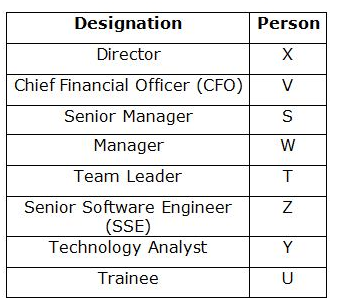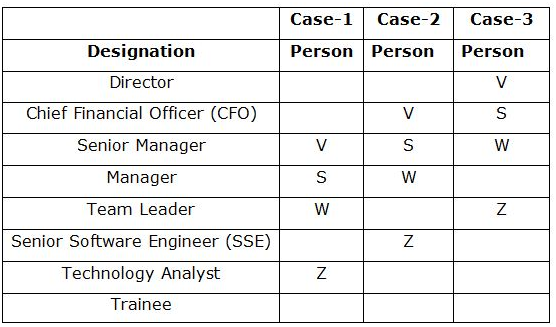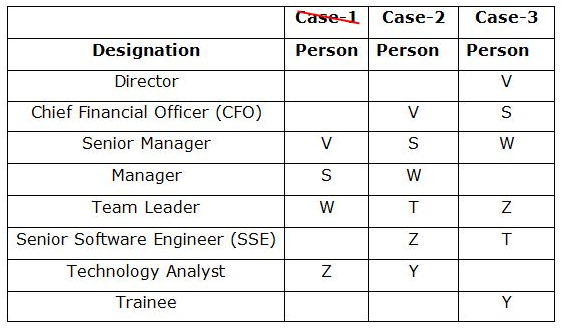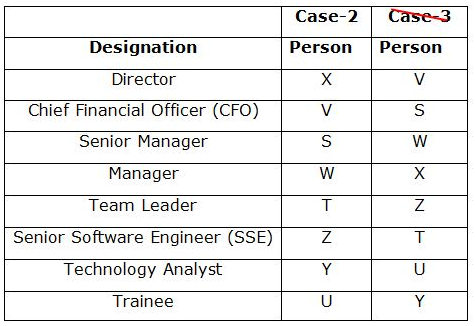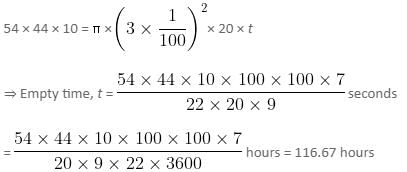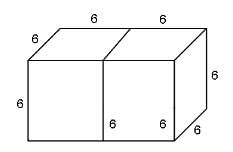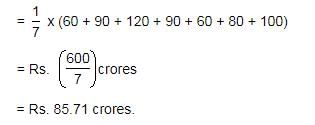EPFO Assistant Prelims Mock Test - 8 - Bank Exams MCQ
30 Questions MCQ Test - EPFO Assistant Prelims Mock Test - 8
Directions: A number arrangement machine when given an input line of numbers rearranges them following a particular rule in each step. The following is an illustration of input and rearrangement.
Input: 62 97 38 74 55 12 86 45 68 22
Step 1: 13 62 97 38 74 55 86 45 68 23
Step 2: 39 13 62 97 74 55 86 68 23 46
Step3: 56 39 13 97 74 86 68 23 46 63
Step 4: 69 56 39 13 97 86 23 46 63 75
Step 5: 87 69 56 39 13 23 45 63 75 98
Find the different steps of output using the above-mentioned logic for the following input.
Input: 88 59 28 94 37 75 15 64 71 48
Q. How many numbers are there between 72 and the one which 4th to left of 76 in step 5?
Step 1: 13 62 97 38 74 55 86 45 68 23
Step 2: 39 13 62 97 74 55 86 68 23 46
Step3: 56 39 13 97 74 86 68 23 46 63
Step 4: 69 56 39 13 97 86 23 46 63 75
Step 5: 87 69 56 39 13 23 45 63 75 98
Input: 88 59 28 94 37 75 15 64 71 48
Directions to Solve
In each of the following questions find out the alternative which will replace the question mark.
Question -
24 : 60 :: 120 : ?
Direction: Study the following information carefully and answer the questions given below.
Eight persons – S, T, U, V, W, X, Y and Z are working in a company with different designations, but not necessarily in the same order. Their designations are Director, Chief financial officer (CFO), Senior Manager, Manager, Team leader, senior software engineer, Technology analyst and Trainee. Director is the senior-most designation whereas Trainee is the junior-most designation.
V is four persons senior to Z, who is not a Trainee. Only one person is designated between V and W, who is immediately junior to S. The number of persons senior to W is the same as the number of persons junior to T, who is two persons senior to Y. X is senior to U. T is not immediately senior to U.
Q. Four of the following are alike in a certain way as per the given arrangement and thus form a group. Find the one who doesn’t belong to that group.
Eight persons – S, T, U, V, W, X, Y and Z are working in a company with different designations, but not necessarily in the same order. Their designations are Director, Chief financial officer (CFO), Senior Manager, Manager, Team leader, senior software engineer, Technology analyst and Trainee. Director is the senior-most designation whereas Trainee is the junior-most designation.
V is four persons senior to Z, who is not a Trainee. Only one person is designated between V and W, who is immediately junior to S. The number of persons senior to W is the same as the number of persons junior to T, who is two persons senior to Y. X is senior to U. T is not immediately senior to U.
Statements :
I. Rahul at present is 25 years younger to his mother.
II. Rahul's brother, who was born in 1964, is 35 years younger to his mother.
Q: In which year was Rahul born ?
Statements :
I. H is the only daughter of X who is wife of M.
II. K and J are brothers of M.
Q: How many children does M have ?
Direction: In each question below is given a statement followed by two conclusions numbered I and II. You have to assume everything in the statement to be true, then consider the two conclusions together and decide which of them logically follows beyond a reasonable doubt from the information given in the statement.
Statements: All the organised persons find time for rest. Sunita, in spite of her very busy schedule, finds time for rest.
Conclusions:
- Sunita is an organised person.
- Sunita is an industrious person.
Direction: In each question below is given a statement followed by two conclusions numbered I and II. You have to assume everything in the statement to be true, then consider the two conclusions together and decide which of them logically follows beyond a reasonable doubt from the information given in the statement.
Q. Some mountains are hillocks. Some mountains are rivers. Some mountains are valleys.
Conclusions:
- All mountains are either hillocks or rivers or valleys
- No valley is river
- Some river are valleys
Direction: In each question below is given a statement followed by two conclusions numbered I and II. You have to assume everything in the statement to be true, then consider the two conclusions together and decide which of them logically follows beyond a reasonable doubt from the information given in the statement.
Q: Some hills are rivers. Some rivers are desrets. All desrets are roads.
Conclusions:
- Some roads are rivers
- Some roads are hills
- Some deserts are hills
Directions: Study the following information carefully and answer the question given below.
'A + B' means 'A is the son of B.'
'A - B' means 'A is the father of B.'
'A x B' means 'A is the sister of B.'
'A * B' means 'A is the mother of B.'
Q. If P + Q * R x S _ T, then how is P related to T?
Direction : Study the following question carefully and choose the right answer.
Q: In a code, CORNER is written as GSVRIV. How can CENTRAL be written in that code?
Statements:
Some people are buyers.
No buyer is market.
Some markets are not malls.
Conclusions:
I.All markets being people is a possibility.
II.No market is people.
A rectangular reservoir has dimensions 54 meters × 44 meters × 10 meters. An outlet pipe of circular cross-section has a radius of 3 centimeters and the water runs through the pipe at a rate of 20 meters/second. What is the time taken by the outlet pipe to empty the reservoir full of water?
Two cubes, each of edge length 6 cm, are joined end to end. The surface area of the resulting cuboid is
When the price of rice is increased by 30 percent, a family reduces its consumption such that the expenditure is only 20 percent more than before. If 50 kg of rice is consumed by family before, then find the new consumption of family (approx.)
Find the last number which when divided by 6, 8, 15 and 30 leaves remainder 2, 4, 11 and 26 respectively?
Study the following line graph and answer the questins.
Exports from Three Companies Over the Years (in Rs. crore)
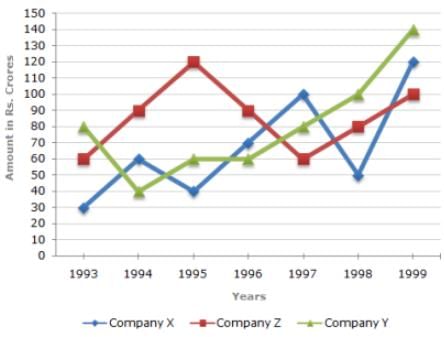
Q. In how many of the given years, were the exports from Company Z more than the average annual exports over the given years?
Study the following table and answer the questions.
Classification of 100 Students Based on the Marks Obtained by them in Physics and Chemistry in an Examination.

Q. If it is known that at least 23 students were eligible for a Symposium on Chemistry, then the minimum qualifying marks in Chemistry for eligibility to Symposium would lie in the range?
Study the following table and answer the questions.
Classification of 100 Students Based on the Marks Obtained by them in Physics and Chemistry in an Examination.

Q. If at least 60% marks in Physics are required for pursuing higher studies in Physics, how many students will be eligible to pursue higher studies in Physics?
Directions: Revenue earned by the Central Government is given in pie-chart. Study the pie-chart and answer the following questions:

Q. The ratio of revenue of the Central Government earned from the Custom Duty and income tax is-
Directions: Revenue earned by the Central Government is given in pie-chart. Study the pie-chart and answer the following questions:

Q. The ratio of revenue earned from excise duty and custom duty to that of other is:
Directions: Study the following pie chart carefully and answer the questions.
The pie chart given below shows the percentage distribution of the total number of male faculties in six different schools.
Total male faculties in all schools together = 8400
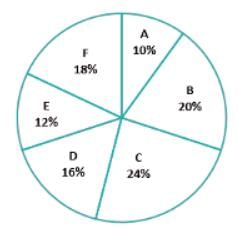
Q. If the total number of faculties in school F is 1820. Then female faculties in school F are what percentage more/less than total male faculties in school B?
In a 4 person race, medals are awarded to the fastest 3 runners. The first-place runner receives a gold medal, the second-place runner receives a silver medal, and the third-place runner receives a bronze medal. In the event of a tie, the tied runners receive the same color medal. (For example, if there is a two-way tie for firstplace, the top two runners receive gold medals, the next-fastest runner receives a silver medal, and no bronze medal is awarded). Assuming that exactly three medals are awarded, and that the three medal winners stand together with their medals to form a victory circle, how many different victory circles are possible?
Larry, Michael, and Doug have five donuts to share. If any one of the men can be given any whole number of donuts from 0 to 5, in how many different ways can the donuts be distributed?
A woman has seven cookies—four chocolate chip and three oatmeal. She gives one cookie to each of her six children: Nicole, Ronit, Kim, Deborah, Mark, and Terrance. If Deborah will only eat the kind of cookie that Kim eats, in how many different ways can the cookies be distributed? (The leftover cookie will be given to the dog.)
Amit throws three dice in a special game of Ludo. If it is known that he needs 15 or higher in this throw to win then find the chance of his winning the game.
The Committee has made / significant changes in / the rules which / will help to banks.
The number of tourists / is expected to rise / from seven to ten percent / in the next ten years.
The _________ nature of the food inflation over the last year has brought the acuteness of food _________ in India into political focus.
Being unsure of itself, reform is pursued _________ by a coalition government constantly _________ of voters' reactions.



